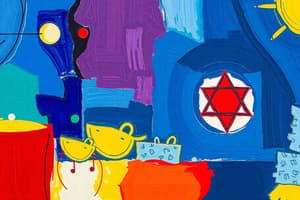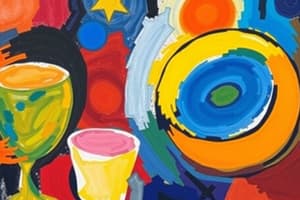Podcast
Questions and Answers
What does Hatarat Nedarim involve?
What does Hatarat Nedarim involve?
- A celebration of the New Year
- The canceling of all promises and vows (correct)
- The act of making promises
- A ritual for confessing sins
Why is Rosh HaShana considered the day of judgement?
Why is Rosh HaShana considered the day of judgement?
- It signifies the beginning of the harvest season
- It is the anniversary of Adam Ha'Rishon's sin (correct)
- It marks the creation of the world
- It was the day when Abraham was tested
What is the meaning of the phrase 'Simana Milta'?
What is the meaning of the phrase 'Simana Milta'?
- Symbols are real
- Deeds are measured
- Words have power (correct)
- Traditions of remembrance
What is the final meal on Erev Yom Kippur called?
What is the final meal on Erev Yom Kippur called?
What happens to a Beinoni's judgement on Rosh Hashana?
What happens to a Beinoni's judgement on Rosh Hashana?
Is it permissible to wash on Yom Kippur?
Is it permissible to wash on Yom Kippur?
Why do we eat apples and challah dipped in honey on Rosh Hashana?
Why do we eat apples and challah dipped in honey on Rosh Hashana?
Who is mentioned in relation to the three books opened on Rosh HaShana?
Who is mentioned in relation to the three books opened on Rosh HaShana?
What does the term 'Beinoni' refer to in the context of Rosh Hashana?
What does the term 'Beinoni' refer to in the context of Rosh Hashana?
What does the word 'Neila' signify during the Yom Kippur service?
What does the word 'Neila' signify during the Yom Kippur service?
What does being classified as a 'Beinoni' mean during Rosh Hashana?
What does being classified as a 'Beinoni' mean during Rosh Hashana?
What does the essence of the custom of Kapparot performed on Erev Yom Kippur signify?
What does the essence of the custom of Kapparot performed on Erev Yom Kippur signify?
Why is reading the book of Yona significant on Yom Kippur?
Why is reading the book of Yona significant on Yom Kippur?
What are the three categories of people mentioned during Rosh Hashana?
What are the three categories of people mentioned during Rosh Hashana?
What does 'Vidur' refer to during Yom Kippur?
What does 'Vidur' refer to during Yom Kippur?
What is the significance of Hatarat Nedarim before Rosh Ha'Shana?
What is the significance of Hatarat Nedarim before Rosh Ha'Shana?
What does the custom of eating apples in honey during Rosh Hashana symbolize?
What does the custom of eating apples in honey during Rosh Hashana symbolize?
What is the main purpose of eating on Erev Yom Kippur?
What is the main purpose of eating on Erev Yom Kippur?
What does the term 'Kol Nidrei' represent in the observance of Yom Kippur?
What does the term 'Kol Nidrei' represent in the observance of Yom Kippur?
What is the primary focus of the extra Shmone Esrei recited during Yom Kippur?
What is the primary focus of the extra Shmone Esrei recited during Yom Kippur?
What is the outcome for someone categorized as a Beinoni on Rosh Hashana?
What is the outcome for someone categorized as a Beinoni on Rosh Hashana?
What does the term 'Kapparot' refer to in the context of Yom Kippur?
What does the term 'Kapparot' refer to in the context of Yom Kippur?
Which action is prohibited during Yom Kippur according to traditional customs?
Which action is prohibited during Yom Kippur according to traditional customs?
What is the primary purpose of the final meal known as 'Seudat HaMafseket'?
What is the primary purpose of the final meal known as 'Seudat HaMafseket'?
What does the prayer 'Kol Nidrei' symbolize when recited on Yom Kippur?
What does the prayer 'Kol Nidrei' symbolize when recited on Yom Kippur?
What is the term 'Neila' commonly associated with during Yom Kippur?
What is the term 'Neila' commonly associated with during Yom Kippur?
Why is it customary to wear white on Yom Kippur?
Why is it customary to wear white on Yom Kippur?
What does 'Simana Milta' indicate in the context of Rosh Hashana customs?
What does 'Simana Milta' indicate in the context of Rosh Hashana customs?
What is Hatarat Nedarim?
What is Hatarat Nedarim?
What is the name of the final meal on Erev Yom Kippur?
What is the name of the final meal on Erev Yom Kippur?
What is the purpose of eating apples or challah in honey during Rosh Ha'Shana?
What is the purpose of eating apples or challah in honey during Rosh Ha'Shana?
Which of the following correctly describes a Beinoni during Rosh Hashana?
Which of the following correctly describes a Beinoni during Rosh Hashana?
What does the term 'Neila' refer to during Yom Kippur?
What does the term 'Neila' refer to during Yom Kippur?
Why is it important to seek forgiveness from others before Erev Yom Kippur?
Why is it important to seek forgiveness from others before Erev Yom Kippur?
What is the significance of the final meal before Yom Kippur, known as Seudat HaMafseket?
What is the significance of the final meal before Yom Kippur, known as Seudat HaMafseket?
What does the custom of 'Kapparot' involve?
What does the custom of 'Kapparot' involve?
During which prayer do individuals traditionally pound their chest?
During which prayer do individuals traditionally pound their chest?
What immediate consequence does a Beinoni face on Rosh Hashana?
What immediate consequence does a Beinoni face on Rosh Hashana?
What are the three categories of people mentioned in relation to Rosh Hashana judgment?
What are the three categories of people mentioned in relation to Rosh Hashana judgment?
What does wearing white on Yom Kippur symbolize?
What does wearing white on Yom Kippur symbolize?
Flashcards are hidden until you start studying
Study Notes
### Rosh Hashana: Traditions and Teachings
- Rosh Hashana is chosen as the day of judgement because it is the anniversary of Adam Ha'Rishon's sin and judgment.
- Simana Milta refers to the symbolic significance of traditions and rituals during Rosh Hashana.
- Hatarat Nedarim is a ritual performed before Rosh Hashana to cancel all promises and vows.
- A Beinoni is someone whose good and bad deeds are balanced. Their judgement is postponed until Aseret Yimei Teshuva and signed on Yom Kippur.
- We eat apples and challah in honey on Rosh Hashana to symbolize the sweetness of new beginnings.
- Hashem only forgives sins between us and people if those people forgive us
- Neila means closing, it is the final prayer of Yom Kippur before the holiday ends.
Rosh Hashana and Yom Kippur Customs
- The three books on Rosh Hashana refer to the categories of people: Tzaddikim, Beinonim, and Reshaim.
- Kapparot is a custom where we take chicken or money over our heads to symbolically transfer our sins.
- Seudat HaMafseket, the final meal on Erev Yom Kippur, is meant to prepare for the fast.
- Kol Nidrei is a prayer recited on Yom Kippur that symbolically annuls unresolved vows.
- Vidur is a prayer said during Yom Kippur where one pounds their chest as a sign of remorse.
Rosh Hashana Overview
- Hatarat Nedarim symbolizes the nullification of previous obligations and promises, allowing for a fresh start.
- The custom of Kapparot involves symbolically transferring one's sins onto a living object, seeking atonement.
- Selichot are prayers for forgiveness recited on Erev Rosh Hashana.
- Neila, the final prayer of Yom Kippur, symbolizes the closing of the gates of opportunity for repentance.
- The prayer Vidur involves a physical act of sincerely lamenting one's actions.
- The three categories of people mentioned in relation to the judgment process are Tzaddikim (righteous), Beinonim (neutral), and Reshaim (unrepentant).
- The practice of saying Kol Nidrei involves a ceremonial release from vows.
- Seudat HaMafseket, the meal on Erev Yom Kippur, is a preparation for the fast.
- Wearing white on Yom Kippur signifies purity and cleanliness.
Studying That Suits You
Use AI to generate personalized quizzes and flashcards to suit your learning preferences.




